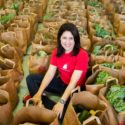Google “food programs in Austin.” Not surprisingly, names like the Sustainable Food Center, Keep Austin Fed, Meals on Wheels, and Austin’s Food Banks and Pantries are among the top organizations listed on Google’s “page one” — and rightly so. Each program works towards improving access to food, especially healthy food, to the 25% of Austin residents living in what the city’s Sustainability Office considers a food desert. And while these organizations are doing great work, one Austin nonprofit is quietly serving more than 1,500 families per week, and its name isn’t found on page one.
Lisa Helfman founded Brighter Bites in 2012 in Houston, and has since opened two additional branches — one here in Austin, the other in Dallas. Through its partnerships with local food banks and Title 1 schools in the city, the non-profit works to provide fresh produce to lower-income families and communities, focusing not only on the food itself, but stressing the importance of food education, exposure, and a positive experience.
In just four years, the program has grown from serving 150 families in one school, to serving 18,000 families in three cities and 75 schools.
Expanding Palates
Each week, families walk away with two bags of food, weighing between 20 and 30 pounds. According to Stefanie Cousins, Brighter Bites’ Director of Marketing and Communications, that number is equivalent to 50 to 60 servings of fruits and vegetables. Distribution and pickup is at one of the program’s eight partner schools.
Along with the food, families receive recipes designed by chefs and nutritionists to inspire creative meals that kids will like. The recipes, Cousins says, are an essential component for nutrition education.
“[We’re] thoughtful about the communities we’re serving, knowing that based on access and education, they’ve been eating a certain way for one to two generations,” Cousins said. “We really just want to increase exposure to fruits and veggies in a risk free environment.”
But food education doesn’t stop with the recipes. Because Brighter Bites focuses on empowering a child’s primary role models — parents, teachers, and peers — teachers also receive two bags of produce each week.
Maggie Whittington, Austin’s Program Director, says teachers use their produce to support their weekly CATCH (Coordinated Approach To Child Health) lesson plans and are given suggestions and ideas from Brighter Bites on how to further incorporate the produce in the classroom.
Whittington says the association between food access, nutrition education, and culinary education is what makes Brighter Bites successful and positively influences the way children eat.
And with recipe favorites ranging from the Hulk Smoothie, a combination of kale, apples, bananas, strawberries, and water, to the Mango Tango Salsa to the Corn and Blueberry Salad, the changing perceptions towards food is apparent.
Essential Partners
Providing 20-30 pounds of produce weekly to more than 1,500 families is no simple feat. Both Cousins and Whittington attribute the program’s weekly successes to its partners, the Central Texas Food Bank and Sysco’s FreshPoint.
While the Central Texas Food Bank sources food on behalf of Brighter Bites, often times supplying the bulk of that 25-30 pound weight average, Whittington says Sysco’s Fresh Point provides some of the delicate, more desirable ingredients, like tomatoes, peppers, and fresh greens, that are often hard to come across at a food bank.
“[What we have] is all seconds, or surplus agricultural products,” said Whittington. “[Our program] provides a resource for foods that would otherwise go bad. The foods are still good, they’re just typically not as pretty.”
Even with the help of their partners, there’s a lot of planning that goes into weekly distributions. Cousins says it’s a lot of juggling numbers to ensure each bag contains the right amount of produce.
“We know how much an apple weighs, or how much a cucumber typically weights,” said Cousins, “so [based on that information], we can estimate how many items of that particular produce we need to include in the bag.” According to their numbers, a full bag usually contains around 10 pieces of produce.
Delivered between 7 a.m. and 8 a.m., the food arrives at each school on large pallets, where a group of volunteers then spends the morning filling the bags. Cousins describes the scene as a “sea of red” with tables lined up along the walls of the cafeteria and volunteers in red shirts busily working.
Distribution, though, occurs after school hours where volunteers and Brighter Bites staff members arrange interactive games and a small sample of a meal the families can anticipate from that week’s bag.
A Brighter Future
Since it began in 2012, Brighter Bites has served nearly 20,000 families and delivered more than 11 million pounds of produce in three cities. Brighter Bites is currently working with eight schools in Austin and is hoping to add more schools in the future.
Cousins says the nonprofit will be growing outside of Texas in the near future, opening two more partnerships in 2017. Applications for Austin schools to participate are due April 1st.
The organization has grown from infancy to adolescence in less than four years, which means there are always opportunities to get involved. Whether it’s helping with bagging in the mornings or distributing bags to families at the end of the day, Brighter Bites could always use an extra set of hands.
To learn more about getting involved, visit their website.
Feature image courtesy of Facebook







